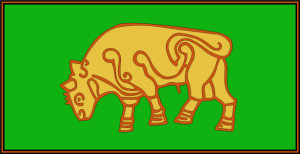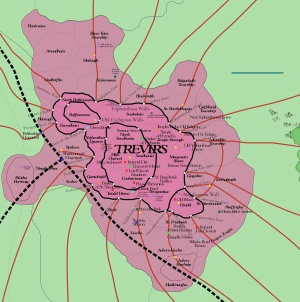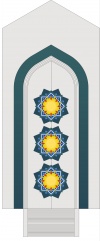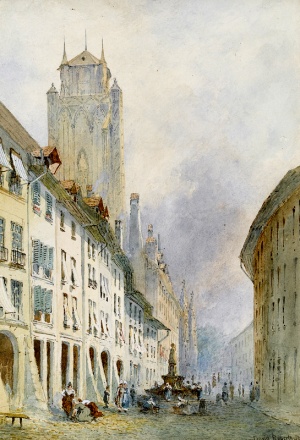Trevirs
Trevirs is the most populous human city in the Pallathantic Region with 960,000 inhabitants, the fourth most populous in the old world, and heir to a past reaching back into the mists of human history. Trevirs rests atop a large prominence of hills in the Magdanalate of the Empire of Magdala. The Palace of the Imperial Diet rests in Trevirs. Historically, Trevirs was also the place of the Imperial Palace. The city is sometimes called Great Trevirs to distinguish it expressly from Royal Trevirs. Trevirs arose in very ancient times as a Pytharnian Giant settlement and eventually came under control of various human tribes. Since the Fall of the Yophenthean Empire, Trevirs has served as an important skyport between the western Jaggudorns, Medibgö, and the Pallathantic Region. Trevirs is the financial capital of southeastern Pytharnia and the seat of the headquarters of several important organizations including the Dwarven Dragonrail Guild of Pytharnia and the Sovereign Archguild of Master Titancrafters of Pytharnia. Trevirs remains the seat of the Palace of the Imperial Diet of Magdala.
Geography and Situation
Trevirs rests upon the prominence of several hills in the hilly Magdalanate. Modern Trevirs includes several suburbs that meet the Yoise River which flows past the city to the north. The metropolis is in the heart of the Pytharnian Highlands at roughly 4.85 DF (610 gnö or 780m or 2560ft) above sea level. The borough of Iblatha Barrhuig rests on a prominence to the west of the historic city and has been part of the city since the late 2600's. There are four historic systems of walls or circumvallations to the city. The oldest encloses the historic center, including North Sewdhainia, High Chancel, Sewdhainia, and Caohirrimur. Nearly as old is the Bafftammon borough, also enclosed in its own wall to the northwest where it lies on a prominence of the hills. These two areas are the most ancient and their great, cyclopean walls were built by the forebears of the Kemerite Giants well over eight thousand years ago. These ancient walls have been superficially modified by later civilizations, but their core structure remains.
The air is mildly humid throughout the year with frequent rainfalls in spring and late autumn, and occasional shows through the summer. The weather is chilly in the winter and mild in the summer, with some summers verging upon hot and muggy. Due to its elevation and separation from the Pallathantic Sea by the Mathgefrew Mountains, Trevirs experiences at least two or three snows in the winter. Despite this, the Pallathantic Sea does moderate the weather of Trevirs as it does most of Pytharnia, so winter rainfall is generally more likely than snow. In the winter, cold mountain breezes from the north are not uncommon. Spring brings winds from the north and the west. In the summer, winds prevail from the southwest, if at all.
Chief Sites
Palace of the Imperial Diet
Boroughs
Trevirs is comprised of forty two boroughs that rest both within and without the historic walls. The boroughs are based upon historic districts of the inner city, townships along the Yoise River, and adjacent barrhuigs or fortified towns atop neighboring hills for added protection to the main city of Treivrs. The boroughs are: Ackery Barrhuig, Ackery-Liocha, Annudhain, Bafftammon, Baniryoise, Belgachaib, Blacksmith, Braffergha, Caohirrimur, Citadel, Dragon Knight, Farvedhain, Gaffdiseal, Gantahufel, Gisgedine, Haiseagh, Harleagh, Heailmurgha, High Chancel, Iblatha Barrhuig, Ifosk, Kishrimmer, Lalondela Township, Liocha, Murgavain Slums, Nirgabarrhuig, North Baftammon, North Sewdhania, Ondbriffin, River Yoise Township, Saint Aireánnau's, Saint Bambdringot's, Saint Friadora's, Scoher, Sewdhania, Sprileen, Swahalain, Tandel House, Tarrhabiaith, Temple, Throguntiac, Yophenthean Quarter. These boroughs are administrative districts based upon historic neighborhoods.
Demographics and Enclaves
Dragonneath
Dragonneath is the informal term for the sprawling network of under-rail tunnels and associated underground tunnels and chambers beneath Trevirs. Most of the Dragonneath that is known to the public is part of the Trevirite Under-Rail. A few portions are part of ancient monastic catacombs. The sewage system at some points meets with the Trevirite Under-Rail system. However, there is an illicit portion which the authorities strive to fill in or seal up which connects to the chambers where chaos cultists are thought to convene to practice their foul religion. Despite the vigilance of the authorities, new tunnels to these places occasionally spring up. Of course, the most infamous places in Dragonneath are those associated with the headquarters and warehouses of organized crime.
Law and Government
Lord Mayor
Defenses
Culture and Festivals
Citywide Festivals
Institutions of Education
Philosophical College of the Yoise
Archguild School of Magitechnics at Trevirs
Archguild School of Trevirs
Archmage's College
Arathracian Gymnasia
Economy
Transportation and Infrastructure
Essence Servoes
Trevirite Under Rail
History
The history of what is modern Trevirs extends back into time under many peoples and names well over three thousand years.
Antediluvian Trevirs
There is no human or humanlike evidence from the antediluvian period of Trevirs according to most authorities. Our dubious knowledge of antediluvian Jhelassa is dubious at best as it is preserved in legends transmitted through different cultures.
Ancient Geddamin Giants
Jhelassa
Neptultchi Dominion
Early Moigthe
Late Moigthe
Yophenthean Rule
Golden Empire of Pytharnia
Llawffagainian Rule
Humanlike and Mage Rule
Rule of the Wizards Council
Rule of Kualotha of the Groaning Earth
Twelfth Isbajath and early Joint-Rule
Medibgóëse Rule
Magdalan Rule
Great Fire of Trevirs
The Great Fire of Trevirs, 2603, changed the cityscape of a core area and was the basis for the creation of Royal Trevirs.
See Also
| This article is a stub. It requires further development by the creator. |



